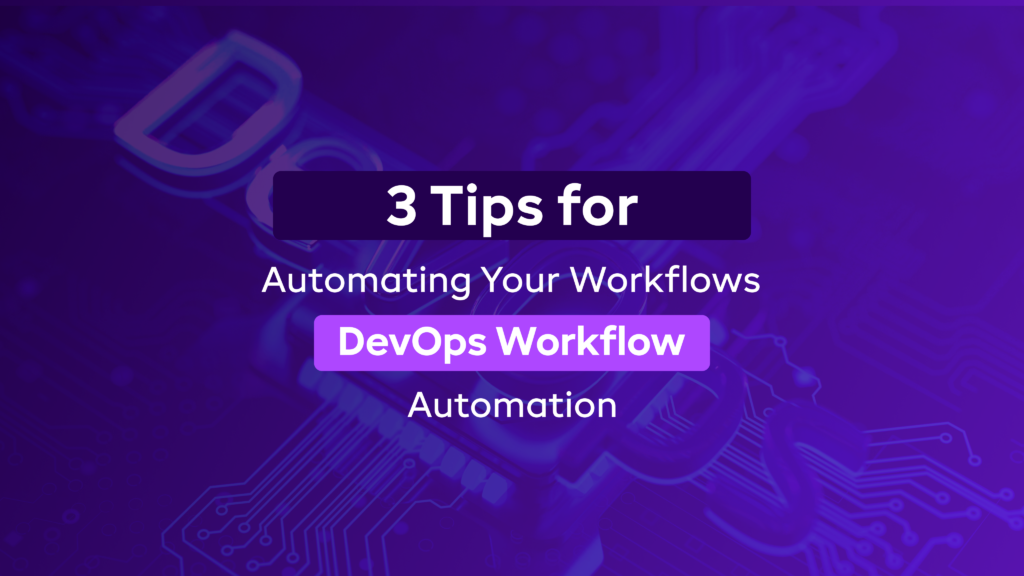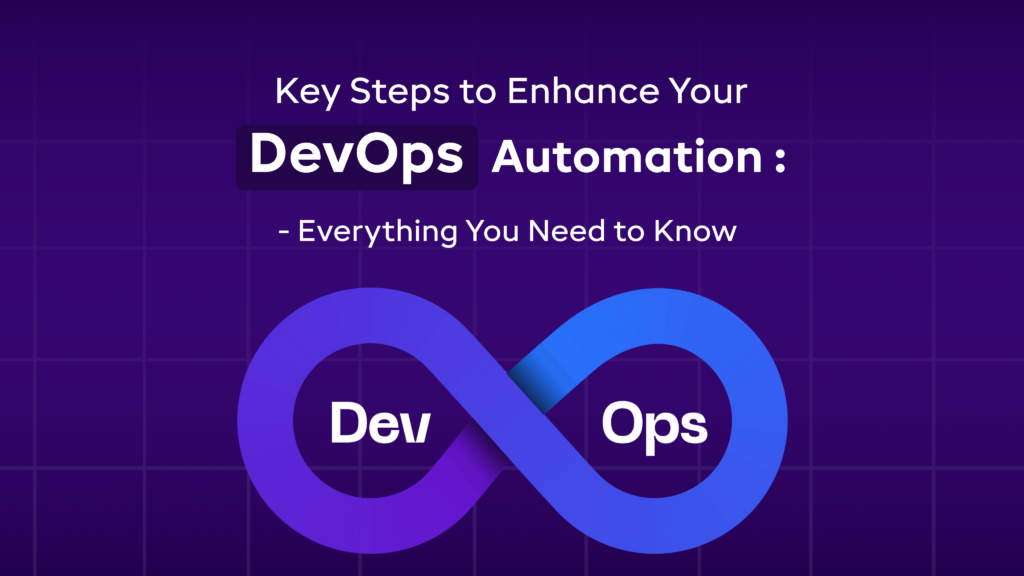DevOps Workflow Automation: 3 Tips for Automating Your Workflows
Published on July 24th 2025

Introduction
In fast-paced development environments, manual processes can quickly become roadblocks. DevOps solutions help automate workflows, enabling teams to eliminate bottlenecks, reduce errors, and deliver software more efficiently.
But automation isn’t about adding tools; it’s about creating smart, reliable workflows that work seamlessly across development, testing, and deployment.
This article shares three practical tips to help teams automate DevOps workflows with purpose and precision, enabling them to move faster, stay agile, and maintain consistency at scale.
What is DevOps Workflow Automation?
DevOps workflow automation includes the following critical aspects:
- Continuous Integration (CI): Automation technologies merge code updates from numerous developers into a single repository. This DevOps service enables the early detection of conflicts and bugs, allowing teams to address them promptly while maintaining code quality.
- Continuous Delivery and Deployment (CD): Automation tools allow for the continuous delivery and deployment of applications. This involves automating application packaging, deployment, and setup across multiple environments, including development, production, testing, and staging.
- Continuous Testing: As part of the CI/CD process, automation is used to run a variety of tests, including performance checks, unit tests, and integration tests. Automated testing ensures that code updates are thoroughly evaluated for quality and functionality before deployment.
- Infrastructure as Code (IaC): Automation technologies, including configuration management and infrastructure provisioning software, enable the automated generation and management of infrastructure resources. This enterprise DevOps solution helps ease infrastructure setup as it is expressed as code, making it easier to deploy and maintain infrastructure across multiple environments.
- Monitoring and logging: Automation tools track the health, performance, and availability of applications and infrastructure. Automated monitoring and logging enable the early detection of problems, facilitate effective troubleshooting, and expedite incident response and resolution.
Want to start a project with us?
Empowering businesses to achieve greatness through strategic guidance and innovative solutions.
Book A Demo
DevOps Workflow Automation: 3 Tips for Streamlining Your Software Development Lifecycle
DevOps teams can automate multiple aspects of the software development lifecycle to optimize operations, enhance collaboration, and deliver high-quality software more efficiently.
In this section, we'll examine three key strategies for efficiently automating your DevOps operations and reaping the benefits.
1. Recognize automation opportunities and optimize DevOps processes.
To begin automating your workflows, assess which aspects of your DevOps processes may benefit the most from automation. Begin by reviewing your organization's software development lifecycle, which includes everything from code generation to deployment and monitoring.
Look for manual procedures that require a substantial amount of time and effort, such as environment provisioning, testing, and deployment. These jobs are ideal for automation. You may free up development teams by automating repetitive and time-consuming tasks.
Utilize open-source DevOps technologies, such as Jenkins, Kubernetes, and GitHub, which offer powerful automation capabilities. These technologies integrate seamlessly with your existing toolchain, enabling you to automate critical operations such as application development, testing, and deployment. Furthermore, open-source programs offer scalability, flexibility, and strong community support.
2. Use automation tools and API integrations
Choosing the appropriate automation tools is critical for effective DevOps process automation. Look for solutions that match your organization's process and offer comprehensive functionality to meet your requirements.
For example, Microsoft Azure and AWS provide full cloud-based solutions for automating your development and deployment workflows.
Integrating various tools and technologies into your workflow is crucial for automation. APIs are crucial for facilitating seamless communication and data sharing among the various components of your DevOps ecosystem. Use APIs to integrate technologies such as version control systems, testing frameworks, and monitoring dashboards, resulting in an interconnected and simplified workflow.
ActiveBatch is another automation tool worth considering. ActiveBatch is a powerful workload automation platform that provides a range of capabilities to help you automate and enhance your DevOps operations. ActiveBatch enables you to consolidate and automate operations across your entire organization, linking all business-critical systems and applications.
3. Continuously monitor, iterate, and improve
Automation is an iterative process that requires continuous monitoring and improvement. Set up real-time analytics and notifications to gain visibility into your automated operations. Dashboards and monitoring tools enable your operations teams and stakeholders to track the performance and health of your production environments, allowing for timely response in the event of bottlenecks or difficulties.
Regularly assess your automated operations to discover opportunities for improvement. Encourage input from team members participating in the automated process, and iterate depending on their findings. This collaborative approach ensures that your automation initiatives are aligned with your organization's evolving needs.
Furthermore, use testing environments to verify your automation procedures before deploying them in production. This technique facilitates the identification and resolution of any issues or potential failures. Ready to streamline your operations? Connect with your nearest DevOps development services today!
Deliver High-Quality Software At Faster Pace
Automation is crucial for enhancing collaboration, accelerating delivery, and ensuring code quality throughout the development and deployment pipelines. However, it is critical to strike a balance between automation and human participation, as some jobs may still require human decision-making or intervention.
You can increase the efficiency and scalability of your processes by utilizing the right automation technologies, such as ActiveBatch, and integrating open-source DevOps tools like GitHub, Jenkins, and Kubernetes. APIs enable seamless communication and data sharing between various tools and systems, resulting in a more efficient and integrated workflow.
Frequently Asked Questions about DevOps Workflow Automation
Q. What Part Does Orchestration Play in Automation for DevOps?
An essential component of DevOps automation is orchestration. To ensure seamless and effective execution, it entails organizing and ordering different workflow activities, tools, and systems. By controlling dependencies, parallelism, and error handling, orchestration tools in the DevOps environment enable the automation of complex operations.
They guarantee the coordination of the many phases of the DevOps lifecycle, including as development, testing, and deployment. Tools for orchestration, such as ActiveBatch, facilitate process optimization, resource allocation, and end-to-end visibility into automated workflows.
Q. Is It Possible to Use DevOps Automation in On-Premises Settings?
The correct tools and procedures may be used to deploy DevOps automation in on-premises settings. Businesses can use automation technologies that work with Linux-based systems and other on-premises infrastructure.
From source code management to continuous deployment, it enables effective management of the software engineering lifecycle. To successfully integrate DevOps automation into their on-premises settings, organizations can utilize best practices and iterative methodologies, such as continuous integration and iterative development. Python and other scripting languages may be used for on-premises integrations and bespoke automation programs.
Conclusion
Effective DevOps automation isn’t just about speed; it’s about building reliable, repeatable systems that support long-term growth. By focusing on high-impact areas, selecting the right tools, and partnering with the right DevOps services in India, organizations can streamline workflows without sacrificing control.
These three tips offer a strong foundation, but the key is continuous improvement. As your infrastructure evolves, so should your automation strategy. The more aligned your workflows become, the closer you get to true DevOps maturity. Start small, iterate often, and keep improving.

About Author

